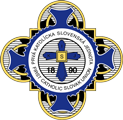Over 100 million Americans are the descendants of 17 million immigrants who were processed through Ellis Island in New York harbor.
I have done not only a study of immigrant Sisters who were members of the SSCM’s, but also of the many Sisters whose blood sisters joined the congregation. According to my count, twenty-eight pairs of sisters became Sisters of Saints Cyril and Methodius. Besides this statistic I have a few others of interest. There were four sets of three Sisters. Actually we had five but one of the three sisters died at age 17. Another really remarkable fact: four sisters from Wilkes-Barre, PA, joined our congregation and three sisters from NYC became SSCM’s. Later, however, the two younger ones transferred to the Erie Benedictines. Another interesting fact, Sister Judith entered our congregation, but her sister became a Sister of Christian Charity whose name in religion is Sister Nivarda.
- Sister Bernadette Marie Ondus, SSCM

Sr. M. Esther and Sr. M. Dionysia
When examining the lives of individuals, it is enlightening to see the workings of the Lord in their hearts in powerful and mysterious ways. The mother of two sisters, Sisters Esther and Dionysia who became Sisters of Saints Cyril and Methodius, died at the age of 28 after giving birth to four children. When she died her son Joseph was only two years old. Sister Esther tells us that she learned from either close relatives or friends that her mother had wished to become a Sister. What is even more striking and noteworthy is the way both sisters were introduced, so to speak, to their future vocation.
When Mary was about nine years old she saw a Sister for the first time. One day as she boarded a streetcar she saw a Sister sitting near the entrance and was fascinated. (It was probably a Mercy Sister on the staff of a hospital in Lewistown which was about 30 miles away.)
 Her sister Helen had a similar experience and was drawn to consider religious life. She says, “As I attended Mass one First Friday in a church close to my home I observed the Ursuline Sisters as they led the children to Holy Communion. It reinforced my desire to be of service to others in some way.”
Her sister Helen had a similar experience and was drawn to consider religious life. She says, “As I attended Mass one First Friday in a church close to my home I observed the Ursuline Sisters as they led the children to Holy Communion. It reinforced my desire to be of service to others in some way.”
The year the Sisters of Saints Cyril and Methodius were founded in Scranton, PA, one of their future members, Mary Yambor, was born on February 4, 1909, in Žedan, Abauska Župa, Slovakia. The family first immigrated to Connecticut and then to Lisbon Falls, Maine, on the Androscoggin River where Dad worked in the logging mills. When Mary was six her mother died. After her death Mary went to Johnstown, PA, where she lived with a great uncle. For a few months she was taught by Franciscan Sisters who wore black habits with a white cord at the side. Unfortunately, when Mary went to stay with another great uncle’s family, she had to attend a public school.
Two significant events guided Mary to the SSCM’s. First of all, she read about the congregation in the AVE MARIA. She also learned that Sister Hilda from Maine had become a Sister of Saints Cyril and Methodius. Mary, therefore, a parishioner of St. Andrew Parish in Pejebscot also decided to become a Cyrilite. She entered on the feast of St. Teresa of Avila, October 15, 1924. Her fondest memory of the day she became a novice in May 1925 was being clothed in a bridal gown. It is especially significant that her favorite saint, St. Teresa of Avila, used marriage imagery in her writings.
Sister Esther had high regard for Sister Hilda and regarded her as a model and inspiration. She described Sister as “intelligent and helpful, a musician, gifted as an instrumentalist and vocalist.” Sister Esther sought to follow in Sister Hilda’s footsteps and when asked what virtue she herself possessed declared without hesitation “helpful.”
Sister Esther taught for many years in the intermediate grades, but her greatest love was teaching piano. For over 25 years she taught in the Villa Music Conservatory. According to Sister Pamela Smith, all the piano teachers found the annual auditions a particularly challenging time. Sister Esther, however, was able to deal with the stress by taking a quick walk to town or enjoying a treat of peanuts.
Those who visited the novitiate over the years for vocation retreats will always remember Sister Esther as “the one who had the kindest words, the warmest welcome, and the sweetest chuckle.”
Sister Esther was also artistic and especially enjoyed painting and drawing. In her heartfelt thoughts of Sister Esther, Sister Jeanne Ambre reveals her admiration: “Sister Esther appreciated beauty. She often told me about some beautiful thing she had seen in a store downtown, saved up for, and walked to town to purchase. Many of these objects had special places in her music room and came out seasonally to add visual beauty to a room which already held beautiful musical compositions. The look of awe in her face, but especially in her eyes, when she held these things told me she could see beyond the wood, metal or plaster from which it was made into the heart and mind of the artist. I knew this is how she must see God, too, since God’s handiwork is everywhere.“
Continues Sister Jeanne: “Sister Esther has always been very supportive and affirming of me as an artist; she always told me what she saw in the images I drew and how much she enjoyed my work. Twice I was able to help her with an art project that she wanted to try. She made a design of roses, transferred it to a sheet of copper and then, working on the wrong side of the sheet, created a bas-relief sculpture which we filled with clay and mounted on a board. She gave these to friends of hers who had done her some kindness or showed her hospitality over the years. I was happy to be able to help and grateful to have seen Sister Esther create something even more beautiful than some of the things she had walked into town to purchase.
What makes Sister more endearing to me than her love of beauty, says Sister Jeanne, is the way she treats other people. There is a deep-down gentleness and reverence for everything that is done for her, even when the person giving is not gentle or reverent. I am delighted to be her friend and proud to be a card-carrying member of her fan club.”
Sister Esther was also an inspiration to a family member, her sister Helen, with whom she corresponded. Helen, also born in Slovakia, on June 8, 1912, entered the congregation on December 7, 1930, from Holy Trinity parish, Yonkers, NY, joining Sister Esther who had entered six years before. Helen became a novice, taking the name Sister Dionysia, on July 7, 1931, which at that time was the Feast of Saints Cyril and Methodius. Professed in August, 1933, she served the Church by preparing little ones for the Sacraments of Penance and Holy Eucharist. Before retiring to Maria Hall in 1992, she was a teacher’s aide. In 1993 she celebrated her Diamond Jubilee.
Sister Dionysia lived as the Blessed Mother had, in quiet prayer and dedicated service. A special event enabled her to come to a better understanding of Mary’s message when she had the opportunity to travel to the shrine of Our Lady of Fatima in Portugal.
Sister Dionysia was hospitalized on the Feast of All Saints and died on the feast of Christ the King, November 20, shortly before the community assembled for Mass at Maria Joseph Manor where she had been recuperating. The Mass of Christian Burial was celebrated on November 23.
When Sister Esther reached 75 years as a religious, a milestone indeed, she commented, “I’m grateful to the Lord.” She joyfully participated in the liturgy celebrated at the Motherhouse and the dinner held at the Meadows Community Center. At the time she was living at Emmanuel Center and made a typically gracious comment, “People are kind.” On Christmas Day in 2002 Sister Esther died and was buried in the Sisters’ cemetery after a Mass of Christian Burial on the Feast of the Holy Innocents, December 28.



